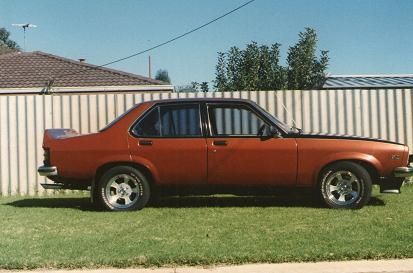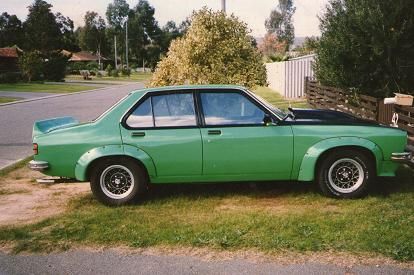Aussie Muscle Cars part 3 - V8 Toranas

Background
In 1967 after Ford won at Bathurst with there 289 powered XRGT. Holden retaliated in 1968 and 1969 by winning with their own 327 and 350 powered Monaros.
In 1970 they went down a completely different path however by reworking the sporty 6 cylinder LC GTR Torana, This subsequently was known as the GTR XU1.
The following model Torana the LJ also resulted in a GTR XU1 model with 202 ci six and triple carbs. These cars were really small compared to the Full sized Fords and Holdens at the time.
So the lack of Cubic inches wasn't the issue it may have been. The story of these little Toranas may be a subject for a later date but today we want to talk about the V8's.
In 1972 a V8 powered version of this tiny XU1 was on the drawing boards, as was the GTHO phase 4 from Ford and the E55 Charger from Chrysler. All but the E 55 charger (and that was sold in a watered down version) were killed off by the "Supercar Scare" of late 72, something we talked about previously.
So For 1973 Holden continued to race the LJ 202, although rule changes that year meant that the little Torana was starting to fight an uphill battle, as the big fords were allowed to use bigger tyres and actually use some of that Horsepower.
LH Torana
For 1974, Holden Released the LH series of Torana, all 4 doors, which was a lot bigger and heavier than the previous models, closer in size and weight to a full sized Holden family sedan.
As such it made the fitment of a V8 a more palatable option to the naysayers of 1972.
This car was made in 4cylinder, 6 cylinder, 253 cid V8 and the big daddy at the time the SL/R 5000 (a 5 litre, (L31) 308 cid variant). They all ran standard bodywork except the SLR 5000 which came with front and rear spoilers. All with 13" rims and tyres (even the 308 version).
On the street the SL/R 5000 was a handy little weapon, but on the racetrack it had a lot of shortcomings, 13" wheels to startwith and a suspect a engine bottom end, and a differential that didn't appear to be very durable.
L34 Variants
So Holden came up with a Variant starting with a new L34 version of the 5 litre V8. The car was never officially named the L34 (that was simply the Engine Code) in fact Holden denied the car even existed initially.
The L34 engine block was cast by Repco based on the Formula 5000 engine that they had built. Although looking very much like the L31 Holden Engine on which it was based it was in fact very different.
The changes consisted of a stronger casting around the bottom end, fully grooved main bearings, stronger conrods with bigger main caps and bolts, solid skirt pistons, ported and polished heads with bigger valves, needle roller - rocker arms (although not a full roller rocker as we know them), stronger pushrods and guide plates, twin coils and twin point distributor, port matched inlet manifold, Headers, big baffled sump, hi output fuel pump, better radiator, stronger clutch, lightened flywheel.
For an extra $1500 dollars you could get Big solid race cam and lifters, full roller rockers, different piston rings, oil coolers, 780 cfm Holley (instead of Rochester). For another small sum you could order a Super T10 gearbox instead of the M21 Aussie box.
The L34 engined SL/R 5000 also had the following :- heavy duty tailshaft, axle tube baffles, 14 x 6 Pontiac Rally wheels (dished out with 1'' more offset), Bigger front discs off the full sized Holdens (and susquently a different stud pattern all round than that of the run of the mill L31 SLR 5000) in addition to the Front and rear spoilers of the L31 engined cars, the L34 versions came with bolt on wheel flares, the original bodywork under these flares was cut away( and in an extremly rough and ready manner). In addition L34 equipped SL/R 5000's had round headlights rather than square ones of all the other Lh Toranas including the L31 engined Sl/R 5000 cars.
Perhaps the weirdest thing was that despite various modifications the little banjo diff was retained, which proved to be achilles heel of the car. Around 263 L/34 Engined production SL/R 5000s were built. Ironically despite all these modifications, when Holden finally admitted the car existed, they quoted the same Horsepower as the garden variety L31 SL/R 5000!!!!
The "L34" Torana was several seconds a lap faster than the Falcons in practice at Bathurst in 74 but a variety of dramas kept them out of first place at race end, which went to the Bartlett/Goss Falcon Hardtop a real tortoise and hare scenario. In 75 and 76 they well and truly had the bugs ironed out and won Both races respectively. Although the baby diff still caused plenty of concern, many failing and others finishing with the diffs in tatters.
LX Torana
In 1976 Holden Released the LX series Torana, these came in 4 door version which really didn't look a whole lot different to the LH (except they had round headlights accross the range). But there was now a 2 door hatchback version. As per the LH both these body configurations came in 4, 6 and V8 versions. The L31SL/R 5000 4 door model continued and you could buy a 5 litre SS Hatchback. There was no L34 version as by now Aussie Regulations meant that there was no way that the L34 motors could meet the Emmision standards. The Earlier model LH L34 engined SL/R continued to be the car of choice for racing.
By 1977 it was realised that something really needed to be done about the lack of reliability in the diff on the racecars (and for that matter street cars, I myself became proficient in changing these on the side of the road in my L31 LH SL/R 5000).
So Holden Introduced production option A9X.
A9X
Now there are fellas that will tell you that the A9X was built as a Hatch only ( pub experts will go to war with you on this - really). Production option A9X was an option that was available on 5 litre SS Hatch and SL/R 5000 Sedans.
405 Option A9X Toranas were produced for sale to the public consisting of 305 four-door sedans and 100 two-door hatches. That's it end of story.
I was lucky enough to own an A9X option SL/R 5000 and really got sick of blokes telling me that "it must have been an L34 because all A9X's were hatchbacks".
The confusion arose because the majority of A9X racecars were hatches.
In addition to the 405 production cars, GMH made 52 rolling shells, available through the spare parts and accesories department, 41 Hatchback 2 doors and 11 Sedans. Somehow GMH wrangled it that once built by various teams into racecars that they would be able to continue to use the L34 spec engine for racing. Despite no such engine being available in the production cars.
The production A9X optioned cars differed from the garden variety SS and SL/R. In that they had wheel flares like the L34's before them, as well as the front and rear spoilers but A9X also had the addition of a rear facing hood scoop, with an enormous hole in the bonnet under it. They had a completely different rear floorpan ( that was replicated in the later family orientated UC) ( You cannot get the rear end and suspension of an A9X under a normal 308 SS or SL/R5000 without a great deal of floorpan mods). Production option A9X also meant the cars recieved the same pontiac wheels and front brake discs as L34 now with Alloy calipers, but with Rear Disc brakes as an added bonus. These discs were bolted on the end of a more robust LS Salisbury Diff with 2.6:1 ratio (just the thing for that big run down Conrod Straight at Bathurst).
The rear suspension geometry was vastly different too (Hence the Rear Floorpan) and up front there were new upper control arms, steeringarms, suspension mounts and shocks. There was also brake cooling ducts from the front spoiler to the front discs. The steering rack was mounted directly to the chassis and not via rubber mounting, giving a more precise although buzzier feel.
Enginewise all production A9X optioned cars had the low spec emmision friendly L31 308's, the only difference being that the old power sapping belt driven fan was replaced by a Davies Craig electric fan, although just that and the cold air through the bonnet scoop did make somewhat of a difference. (As previously mentioned ,racecars continued to use the L34 Spec Engine). They also came with a heavy duty radiator.
An SL/R or SS Hatch with production option A9X cost $10,700 in 1977 and all production cars were built between August 77 and Jan 78. Optional extras included, at extra cost - a radio (really) as they decided that most people who bought one wouldn't care less !!, and again the Super T10 Gearbox.
Again (as with the L34) the A9X's failed at their first Bathurst in 77, but won in 78 and 79 when Brock won by 6 laps and smashed the lap record on the final lap, before the Torana's were finally retired from Touring car racing.
The last ever Torana was the UC model which was basicly a Mum and Dad midsized family car either in 4 or 6 cylinder.
Torana is an Aboriginal word meaning "To Fly".


